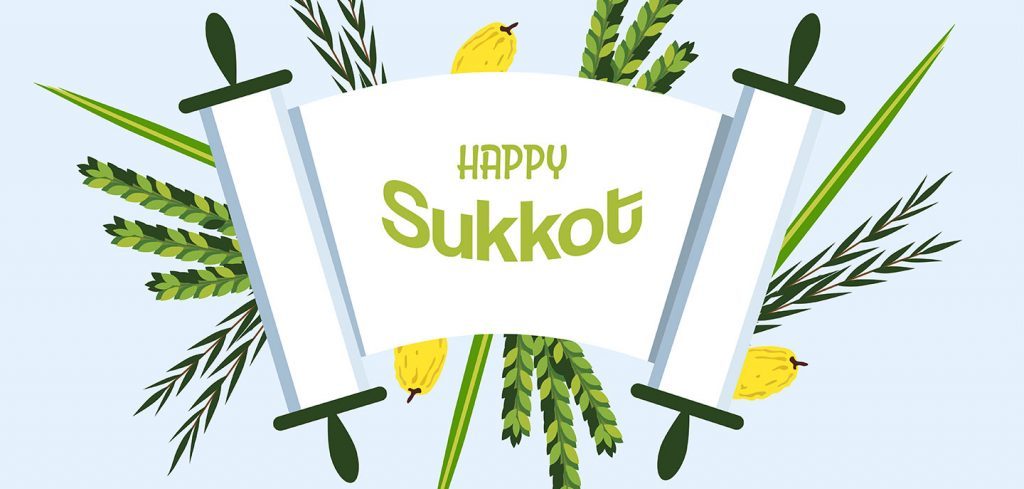This Year the Holiday of Sukkot, Shemini Atzeret and Simchat Torah begins Friday, October 2, 2020 at Nightfall (6:22 pm Philadelphia Time) – Ends on Sunday, October 11, 2020 after Sunset (7:17 pm Philadelphia)
(In honor of Sukkot, please print BEFORE the Holiday begins – this Document contains G-d’s Name, therefore it may NOT be thrown out)
For a 2 minute video of Sukkot please visit:
As soon as the solemn day of Yom Kippur is behind us, we focus on the traditions of the upcoming joyous holiday of Sukkot. We build a temporary house called Sukkah, which reminds us of the Clouds of Glory with which G-d surrounded the Jewish people in the desert after the Exodus from Egypt.
It is very special to experience a meal in a Sukkah and to ‘shake’ The Four Species (Lulav, Etrog, Aravot and Hadassim). If you have never done either before, visit http://www.cbscommunitycenter.com
You can also visit www.Chabad.org to find a synagogue near you where you can be accommodated.
Elevating the Mundane
When we do a mitzvah (a commandment), we elevate ourselves, the object with which we did the mitzvah, and our environment. Most commandments are focused only on limited aspects of our being and limited dimensions of our environment. However, when it comes to dwelling in a Sukkah, not only is the entire body enveloped by the mitzvah, but so are the most mundane aspects of life. After all, by eating, drinking or even reading a good book in the Sukkah, we perform a mitzvah that encompasses our entire body!

CANDLE LIGHTING
Women (or if there isn’t a woman in the house, the head of the household) lights candles.
Please light from existing fire of a candle you light prior to the Holiday.
For exact times in your area go to:
http://www.chabad.org/calendar/candlelighting_cdo/aid/6226/jewish/Shabbat-Candle-Lighting-Times.htm
On Friday, October 2, 2020 (6:22 pm Philadelphia) and Friday, October 9 (6:11 pm Philadelphia Time) say two prayers below:
1. Ba-ruch A-tah Ado-nai E-lo-hei-nu me-lech ha-olam asher ki-deshanu be-mitzvo-tav ve-tzvi-vanu Lehadlik Ner Shel Shabath vYom Tov
(Blessed are You, L-rd our G-d, King of the universe, who has sanctified us with His commandments and has commanded us to light the candle of Shabath and the Holiday.
2 . Ba-ruch A-tah Ado-nai E-lo-hei-nu me-lech ha-olam she-heche-ya-nu ve-ki-yi-ma-nu ve-higi-a-nu liz-man ha-zeh
(Blessed are You, Lord our G-d, King of the universe, who has granted us life, sustained us, and enabled us to reach this occasion.)
On Saturday, October 3, 2020 (AFTER 7:18 pm Philadelphia) and Saturday, October 10 (AFTER 7:07 pm Philadelphia Time) say two prayers below:
1. Ba-ruch A-tah Ado-nai E-lo-hei-nu me-lech ha-olam asher ki-deshanu be-mitzvo-tav ve-tzvi-vanu Lehadlik Ner Shel Yom Tov
(Blessed are You, L-rd our G-d, King of the universe, who has sanctified us with His commandments and has commanded us to light the candle of the Holiday.
2 . Ba-ruch A-tah Ado-nai E-lo-hei-nu me-lech ha-olam she-heche-ya-nu ve-ki-yi-ma-nu ve-higi-a-nu liz-man ha-zeh
(Blessed are You, Lord our G-d, King of the universe, who has granted us life, sustained us, and enabled us to reach this occasion.)
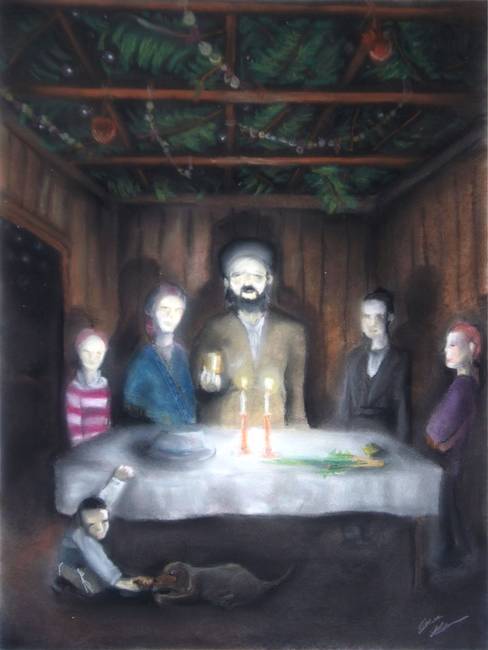
Friday Evening Kiddush (for October 2nd and 9th)
Kiddush is recited while holding a cup of kosher wine or grape juice.
Yom Ha-shi-shi.
Va-y’chu-lu Ha-sha-ma-yim v’ha-a-retz, v’chawl^ts’va-am.
va-y’chal e-lo-him ba-yom ha-sh’vi-i, m’lach-to a-sher a-sa
va-yish-bot ba-yom ha-sh’vi-i, mi-kawl^m’lach-to a-sher a-sa.
va-y’va-rech e-lo-him et yom ha-sh’vi-i, va-y’ka-deish o-to
ki vo sha-vat mi-kawl^m’lach-to a-sher ba-ra e-lo-him la-a-sot.
(Quietly: It was evening and it was morning.) The sixth day. So the heavens and the earth were finished, with all their complement. On the seventh day, God had completed His work which He had undertaken, and He rested on the seventh day from all His work which He had been doing. Then God blessed the seventh day and made it holy, because on it He ceased from all His creative work, which God had brought into being to fulfill its purpose.
Savri maranan ve-rabanan ve-rabosai: Baruch ata Adonoy, Eloheinu melech ha-olam, borei peri ha-gafen. (Others respond: “Amen”)
Blessed are You God, King of the Universe, Creator of the fruit of the vine. (Others respond: “Amen”)
Barukh atah A-do-nai, Elohaynu, melekh ha-olam asher bachar banu mee-kol am, v’rom’manu mee-kol lashon v’kee’d’shanu b’meetzvotav, va-teeten lanu, A-do-nai Elohaynu, b’ahavah shabasos l’menucha umo’adeem l’seemchah, chageem u-z’maneem l’sason, et yom hashabbos hazeh v’et yom chag ha-Sukkot hazeh, z’man seemchateinu b’ahava meekra kodesh, zeicher leetzeeyat meetz’rayeem Ki Vanu Vacharta V’osanu Keedashtsa Mekol Haamim v’shabbos U-mo’aday Kadsh’kha b’ahava u-v’ratzon b’simchah u-v’sason hin’chal’tanu. Barukh atah Adonai, m’kadesh hashabbos v’Yisra’el v’ha-z’manim. (Amein)
Blessed are you, Lord, our God, king of the universe who has chosen us from among all people, and exalted us above every tongue and sanctified us with His commandments, and you gave us, Lord our God, with love shabbos for rest, and appointed festivals for gladness, festivals and times for joy, this day of shabbos and the festival of Sukkot, the time of our gladness with love a holy convocation, a memorial of the exodus from Egypt Indeed, You have chosen us and made us holy among all peoples and shabbos and your holy festivals with love and desire and in gladness and in joy you have given us for an inheritance Blessed are You, who sanctifies shabbos and Israel and the seasons. (Amen)
(On October 2nd only): Ba-ruch A-tah Ado-nai E-lo-hei-nu Me-lech Ha-olam Asher Kideshanu Bemitzvotav Vetzivanu Leshev Basukkah.
(On October 2nd only): Blessed are You, Lord our G‑d, King of the universe, who has sanctified us with His commandments, and commanded us to sit in the Sukkah.
Ba-ruch A-tah Ado-nai E-lo-hei-nu me-lech ha-olam she-heche-ya-nu ve-ki-yi-ma-nu ve-higi-a-nu liz-man ha-zeh
(Blessed are You, Lord our G-d, King of the universe, who has granted us life, sustained us, and enabled us to reach this occasion.)
Saturday Evenings Kiddush (October 3rd and 10th)
Kiddush is recited while holding a cup of kosher wine or grape juice.
Savri maranan ve-rabanan ve-rabosai: Baruch ata Adonoy, Eloheinu melech ha-olam, borei peri ha-gafen. (Others respond: “Amen”)
Blessed are You God, King of the Universe, Creator of the fruit of the vine. (Others respond: “Amen”)
Barukh atah A-do-nai, Elohaynu, melekh ha-olam asher bachar banu mee-kol am, v’rom’manu mee-kol lashon v’kee’d’shanu b’meetzvotav, va-teeten lanu, A-do-nai Elohaynu, b’ahavah mo’adeem l’seemchah, chageem u-z’maneem l’sason, et yom chag ha-Sukkot hazeh, z’man seemchateinu meekra kodesh, zeicher leetzeeyat meetz’rayeem Ki Vanu Vacharta V’otanu Keedashta Mekol Haamim U-mo’aday Kadsh’kha b’simchah u-v’sason hin’chal’tanu. Barukh atah Adonai, m’kadesh Yisra’el v’ha-z’manim. (Amein)
Blessed are you, Lord, our God, king of the universe who has chosen us from among all people, and exalted us above every tongue and sanctified us with His commandments, and you gave us, Lord our God, with love appointed festivals for gladness, festivals and times for joy, this day of the festival of Sukkot, the time of our gladness a holy convocation, a memorial of the exodus from Egypt Indeed, You have chosen us and made us holy among all peoples and your holy festivals in gladness and in joy you have given us for an inheritance Blessed are You, who sanctifies Israel and the seasons. (Amen)
Barukh ata Adonai, Eloheinu Melekh ha-olam, borei m’orei ha-eish.
Blessed are You, Adonai our God, Ruler of the universe, Creator of the fire’s light.
Barukh ata Adonai, Eloheinu Melekh ha-olam, ha-mavdil bein kodesh l’chol, bein or-le’choshekh, bein Yisrael la-amim, bein yom ha-shevi’i l’sheshet y’mai ha-ma’aseh bein kiddushas shabbos l’kiddushas yom tov hivdaltak,v’es yom ha’shvii m’sheishes yimeiha’maaseh kiddashtah, hivdaltah v’kiddashtah es amchah yisrael bi’kidushasechah. Barukh ata Adonai, ha-mavdil bein kodesh l’kodesh.
Blessed are You, Eternal our God, Ruler of the universe, Who distinguishes between the sacred and the profane, between light and darkness, between Israel and other people of the world, between the seventh day and the six days of the week, between the holiness of shabbos and the holiness of the festivals, and the seventh day you sanctified from all the days of work, and you have seperated and sanctified the nation of Israel with sanctity. Blessed are You, Who distinguishes between the sacred and the sacred.
(On October 3rd only)
Ba-ruch A-tah Ado-nai E-lo-hei-nu Me-lech Ha-olam Asher Kideshanu Bemitzvotav Vetzivanu Leshev Basukkah.
(On October 3rd only)Blessed are You, Lord our G‑d, King of the universe, who has sanctified us with His commandments, and commanded us to sit in the Sukkah.
Ba-ruch A-tah Ado-nai E-lo-hei-nu me-lech ha-olam she-heche-ya-nu ve-ki-yi-ma-nu ve-higi-a-nu liz-man ha-zeh
Blessed are You, Lord our G-d, King of the universe, who has granted us life, sustained us, and enabled us to reach this occasion.
Pour some wine into a separate cup for guests and then drink the rest yourself without talking.
Challah in Honey
Immediately following the kiddush, we perform the ritual washing for bread. Fill a large cup with water. Pass the cup to your left hand and pour three times over your right hand. Repeat by pouring on your left hand. As you wipe your hands recite the blessing:
Baruch atah A-donoy, Elo-heinu Melech Ha’Olam, asher kidshanu bemitzvotav vetzivanu al netilat yadayim.
When everyone has returned to the table, we raise the two challah loaves and recite the blessing:
Ba-ruch atah A-do-nay, E-lo-hei-nu Melech Ha-Olam, hamotzie le-chem min ha-are-tz.
Blessed are You, L-rd, our G‑d, King of the universe, who brings forth bread from the earth.
Cut the challah, dip it in honey and have a bite. Pass around pieces and make sure everyone does the same.
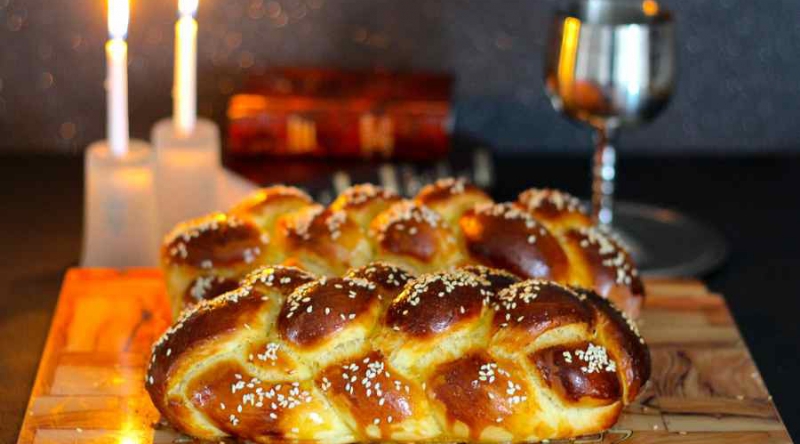
UNIQUE FEATURES OF SUKKOT
On Sukkot there is a special Mitzvah to dwell in special hut called a Sukkah. Therefore one should eat and if one is able to even sleep in this holy abode.
A Sukkah is a hut built to provide shade. That’s why it must sit beneath the open sky—not under a patio deck or even the branches of a tree. The walls can be made of any material, as long as they are secure and don’t flap about in the wind. The roof, however, (we call it s’chach), must be of unprocessed materials which have grown from the ground. Bamboo poles, thin wooden slats, and evergreen branches are popular choices. We make sure to use enough s’chach so that the inside of the sukkah has more shade than sunlight.
On Sukkot, along with the mitzvah of dwelling in the Sukkah comes the Scriptural obligation of “taking” the Four Species as instructed by the verse, “On the first day, you must take for yourself a fruit of the citron tree, an unopened palm frond, myrtle branches and willows of the brook.”
We SHAKE the Four species on all days of Sukkot except Shabbat
The Four Species are co-dependent, and if one of the four is missing, the mitzvah is not fulfilled. In total, seven individual items are required for the mitzvah:
- One Lulav
- One Etrog
- Two Aravot
- Three Hadassim
Why are these four plants used instead of other plants? There are two primary explanations of the symbolic significance of these plants: that they represent different parts of the body, or that they represent different kinds of Jews.
According to the first interpretation, the long straight palm branch represents the spine. The myrtle leaf, which is a small oval, represents the eye. The willow leaf, a long oval, represents the mouth, and the Etrog fruit represents the heart.
All of these parts have the potential to be used for sin, but should join together in the performance of commandments and bring Divine Light into the world.
According to the second interpretation, the Etrog, which has both a pleasing taste and a pleasing scent, represents Jews who have achieved both knowledge of Torah and performance of mitzvot (commandments). The palm branch, which produces tasty fruit, but has no scent, represents Jews who have knowledge of Torah but are lacking in mitzvot. The myrtle leaf, which has a strong scent but no taste, represents Jews who perform mitzvot but have little knowledge of Torah. The willow, which has neither taste nor scent, represents Jews who have no knowledge of Torah and do not perform the mitzvot.
We bring all four of these species together on Sukkot to remind us that every one of these four kinds of Jews is important, and that we must all be united.
The Blessing for the Four Species
Take the etrog in your left hand with the stem (green tip) up and the pitom (brown tip) down. Take the lulav (including the palm, myrtle and willow branches bound together) in your right hand. Bring your hands together and recite the blessing below.
Barukh atah A-do-nai, Eloheinu, melekh ha-olam asher kidishanu b’mitz’votav v’tzivanu al n’tilat lulav (Amein)
Blessed are you, Lord, our God, sovereign of the universe Who has sanctified us with His commandments and commanded us to take up the lulav (Amen)
First Day Only Add:
Barukh atah Adonai, Eloheinu, melekh ha’olam shehecheyanu v’kiyimanu v’higi’anu laz’man hazeh.
Blessed are you, Lord, our God, sovereign king of the universe who has kept us alive, sustained us, and enabled us to reach this season (Amen)
After you recite the blessing, turn the etrog so the stem is down and the pitom is up. (Be careful not to damage the pitom)
With the lulav and etrog together, gently shake forward (East) three times, then pull the lulav and etrog back in front of your chest. Repeat this to the right (South), then over your right shoulder (West), then to the left (North), then up, then down.
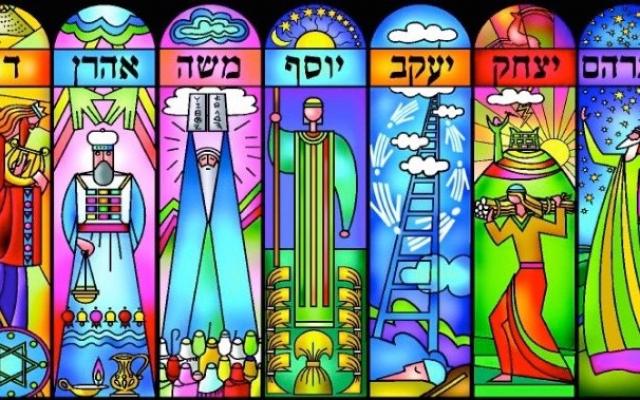
Seven Guests
Sukkah generates an intense concentration of spiritual energy. During Sukkot the souls of the seven great leaders of Israel –Abraham, Isaac, Jacob, Moses, Aaron, Joseph, and King David – actually leave Heavenly realm to partake in the Divine Light of Sukkot. Collectively these transcendent guests are known as Ushpizin, the Aramaic word meaning “guests.”
Each of the seven Ushpizin correspond to a fundamental spiritual pathway through which the world is perfected
Abraham represents love and kindness
Isaac represents restraint and personal strength
Jacob represents beauty and truth
Moses represents eternity and dominance through Torah
Aaron represents empathy and receptivity to divine splendor
Joseph represents holiness and the spiritual foundation
David represents the establishment of the kingdom of Heaven on Earth
We can connect to these energies and learn from our great leaders.
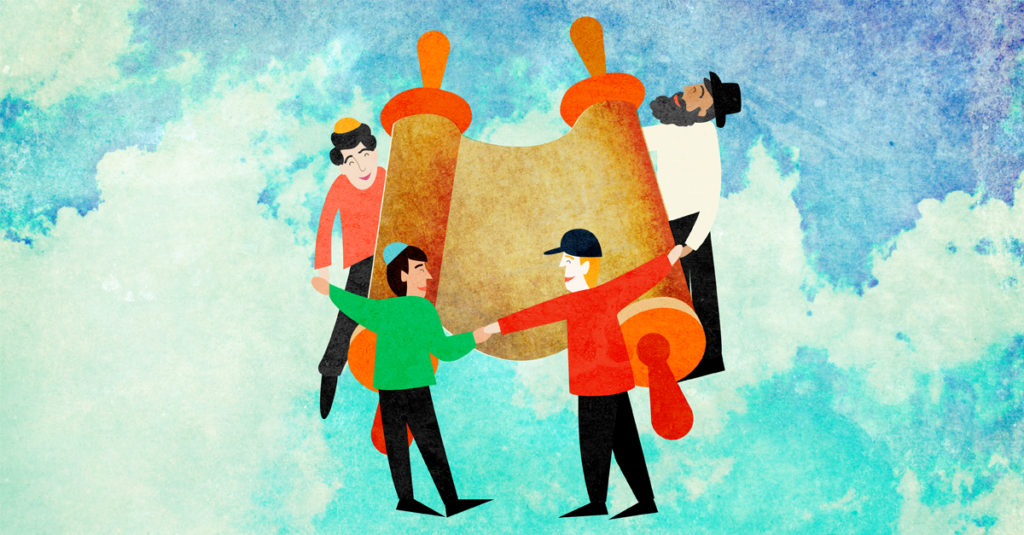
Simchat Torah
Sukkot is the only holiday that really encompasses two holidays:
Seven days of Sukkot and 2 Days of Shemini Atzeret [upon which we celebrate Simchat Torah on the second day].
These final two days begin at sundown on October 9. 2020 (6:11 pm) until nightfall on October 11 2020. (7:06 pm Philadelphia)
On this final day, it is customary to conclude and then immediately begin the annual cycle of Torah reading.
The highlight of this holiday is the boisterous singing and dancing in the synagogue, as the Torah scrolls are paraded in circles around.
Although the eighth day follows Sukkot, it is actually an independent holiday in many respects (we no longer take the Four Kinds or dwell in the sukkah). Jews outside of Israel still eat in the sukkah on the first of the two days of Shemini Atzeret.
The intermediate days (October 5 until sundown on October 9) are quasi holidays, known as Chol Hamoed, except for Sabbath.
One is permitted to drive and use electricity but should still act in ways fitting for a Holiday.
Water and Joy
On Sukkot, G‑d determines how much rain will fall that winter (the rainy season in Israel). Thus while every sacrifice in the Temple included wine libations poured over the altar, on Sukkot, water was also poured over the altar in a special ceremony. This ritual engendered such joy that it was celebrated with music, dancing and singing all night long. This celebration was called was “Simchat Beit Hasho’evah.”
Even today, when there is no Temple, it is customary to hold nightly celebrations that include singing and dancing (and even live music during the intermediate days of the holiday).
For my Short Russian video on the Holiday, please visit:
http://youtu.be/czN9RjqG2gI
For more information visit
https://www.partnersintorah.org/wp-content/uploads/2017/12/sukkot.pdf

